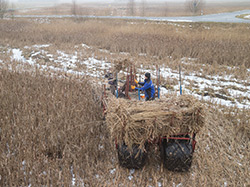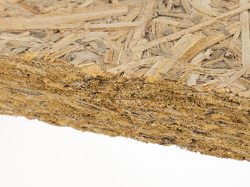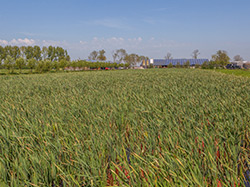Cattail (Typha spp.)
In brief
Narrow leaved bulrush (Typha angustifolia), broadleaf bulrush (Typha latifolia) and their hybrid (Typha x glauca) are highly productive perennial plants native to central Europe. They have vigorous, starchy rhizomes and stiffly emergent leaves that reach heights of 1.5-3 (-4) m. The plants have aerenchyma (spongy tissue with large spaces for air to pass through). These many air chambers make cattails promising as a renewable raw material in the building materials sector.
Location
Degraded, rewetted fens with high nutrient availability are particularly suitable for growing cattails. Irrigation with nutrient-laden surface water is recommended. Ideally, cattail crops are established in areas with nutrient-rich water.
Flyer "Steckbrief Rohrkolben"
Water level: 0 -40 cm above ground (water stage: 5+/6+).
Establishment: By seeding or planting seedlings
Yield: 5-20 t dry matter per hectare per year
Harvest: Annual; first harvest after 1-2 years
Utilization: Eco building materials, bioenergy
Emission reduction: approx. 18 t CO2 eq. per hectare per year (compared to nutrient-rich, drained fens, excluding emission reduction through replacement of fossil fuel based raw materials).
Potential
Natural cattail stands in Germany are highly productive and it can be assumed that targeted cultivation in Germany is possible on a farm scale. The demand for eco building materials is growing. Regional production of the raw material is advantageous for marketing eco building materials. Depending on the quality, farmers can be paid up to 600 euros per ton of raw material.
Establishment

Cattails are perennial plants that grow in permanent crops. Establishment can be through seedlings, rhizome cuttings, or by sowing. Establishment using seedlings results in reliable and fast stand establishment but has higher costs. Ideal germination conditions for seeding are water levels at or a few cm above ground level. Seeding in the months of May - June is recommended. Gaps can be filled with seedlings. Due to rapid vegetative growth, plant densities of less than two plants per m² are sufficient. The number of shoots can increase by a factor of 30 within the first year.
Seed
For the establishment of a cattail culture, seeds can be obtained from natural stands that are similar to those in the cultivated area in terms of nutrient availability and water level. One cob contains over 100,000 seeds, of which over 80% can germinate.
Land preparation
To ensure uniform water levels, the height differences on the surface should not exceed 20 cm. Uniform water levels can be achieved by dividing the area into partial fields, where water levels can be regulated independently. The partial fields should not be too large (<10 hectares).
Management & Yield

Water management and nutrient supply
Cattails achieve good growth performance when water levels are 0 – 40 cm above the ground. Irrigation with water from nutrient-loaded water retention areas can benefit growth but this is not essential if there is sufficient nutrient availability in the topsoil.
Care
At high water levels, only a few other plants will grow. It is advisable to mow the marginal areas regularly in summer to prevent the invasion of reeds. Regular maintenance of irrigation equipment is required.
Duration of the culture
There is still no information about long-term cattail cultivation. However, it is assumed that stands can be used as a permanent crop for 10 years or longer. Harvesting can begin in the first year after establishment. Full yield can be expected from the 2nd to 3rd year.
Yield
Yield of native cattail species depends on harvest date, water level, and nutrient availability and ranges from 5 to 20 tons of dry matter per hectare per year.
Harvest & Utilization

Harvest
When biomass is utilized for material, harvesting occurs from fall through winter. In the case of utilization as fodder, for use in biogas plants, or with the aim of nutrient reduction, earlier harvest dates are recommended.
Due to high water levels, harvesting requires the use of special equipment. Depending on the intended utilization, the cob or the entire plant can be harvested in bunches. Harvesting technology from reed mowing can be used for this purpose.
Use
Due to the many air-filled chambers in the plant tissue, the above-ground biomass offers the best conditions for use as insulation material, e.g., as blow-in insulation material or as insulating board. The fibers of the fruit can be used as filling material. The use of cattails as a substrate in horticulture is currently being tested. Furthermore, there is the possibility of energy production (combustion, biogas, etc.). The calorific value of cattail biomass (as briquettes, pellets, or bales) averages 18.2 MJ per kg, and the ash content is 3.7 - 6.7%. In addition, cattail can be used to naturally filter water in artificial wetlands.
Implementation

Status of implementation
Cattail cultivation has not yet been implemented on a farm scale. A test cultivation was carried out in the Donaumoos (Bavaria, Germany) on 6.2 ha as part of the DBU project "Cattail Cultivation in Fens". Cattail biomass for use as an eco building material has so far been sourced from the Danube Delta or Senegal. For test trials, cattail was harvested from spontaneously established areas in Germany. Trials on the cultivation of cattail is currently taking place in Mecklenburg-Vorpommern and the Netherlands.
In Manitoba, Canada, cattail stands are being harvested in the Lake Winnipeg watershed to remove nutrients and provide biomass for the bioeconomy.
Challenges and barriers
To ensure planning certainty for commercial cultivation, the regulatory framework needs to be adjusted. Cattail cultivation is not yet recognized as an agricultural crop and thus not eligible for funding. Furthermore, deliberately established cattail cultures should be exempted from legal biotope protection. Furthermore, there is no experience yet with long-term management of cattail cultures.
Sources & further information
- Pfadenhauer, J. et al. (2001) Rohrkolbenanbau in Niedermooren – Integration von Rohstoffgewinnung,
Wasserreinigung und Moorschutz zu einem nachhaltigen Nutzungskonzept. Abschlussbericht zum DBU-Projekt Nr. 10628, 119 Seiten. - Heinz, S. (2012) Population biology of Typha latifolia L. and Typha angustifolia L.: establishment,
growth and reproduction in a constructed wetland. Shaker Verlag, 108 Seiten. - Wichtmann, W., Schröder, C. & Joosten, H. (Hrsg.) (2016) Paludikultur – Bewirtschaftung nasser Moore.
Schweizerbart, Stuttgart, 272 Seiten. - Flyer "Steckbrief Rohrkolben"











